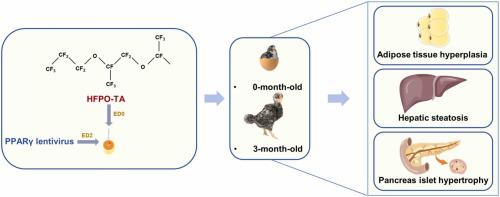当前位置:
X-MOL 学术
›
J. Hazard. Mater.
›
论文详情
Our official English website, www.x-mol.net, welcomes your feedback! (Note: you will need to create a separate account there.)
Persistent metabolic toxicities following developmental exposure to hexafluoropropylene oxide trimer acid (HFPO-TA): Roles of peroxisome proliferator activated receptor gamma
Journal of Hazardous Materials ( IF 13.6 ) Pub Date : 2024-04-17 , DOI: 10.1016/j.jhazmat.2024.134337 Shuping Zhong , Junhua Yuan , Yong Niu , Siyi Wang , Xinxian Gong , Jing Ji , Yuxu Zhong , Yuxin Zheng , Qixiao Jiang
Journal of Hazardous Materials ( IF 13.6 ) Pub Date : 2024-04-17 , DOI: 10.1016/j.jhazmat.2024.134337 Shuping Zhong , Junhua Yuan , Yong Niu , Siyi Wang , Xinxian Gong , Jing Ji , Yuxu Zhong , Yuxin Zheng , Qixiao Jiang

|
Hexafluoropropylene oxide trimer acid (HFPO-TA), a perfluorooctanoic acid (PFOA) substitute, exhibited strong affinity and capability to activate peroxisome proliferator activated receptor gamma (PPARγ), a lipid metabolism regulator, suggesting potential to induce metabolic toxicities. Fertile chicken eggs were exposed to 0, 0.5, 1 or 2 mg/kg (egg weight) HFPO-TA and incubated until hatch. Serum from 0- and 3- month-old chickens were subjected to liquid chromatography ultra-high resolution mass spectrometry for HFPO-TA concentration, while liver, pancreas and adipose tissue samples were collected for histopathological assessments. PPARγ reporter and silencing system were established with lentivirus microinjection. qRT-PCR and immunohistochemistry were utilized to evaluate the expression levels of PPARγ downstream genes. In 3-month-old animals developmentally exposed to HFPO-TA, adipose tissue hyperplasia, hepatic steatosis, pancreas islet hypertrophy and elevated serum free fatty acid / insulin levels were observed. Results of reporter assay and qRT-PCR indicated HFPO-TA-mediated PPARγ transactivation in chicken embryo. Silencing of PPARγ alleviated HFPO-TA-induced changes, while PPARγ agonist rosiglitazone mimicked HFPO-TA-induced effects. qRT-PCR and immunohistochemistry revealed that FASN and GPD1 were upregulated following developmental exposure to HFPO-TA in 3-month-old animals. Developmental exposure to HFPO-TA induced persistent metabolic toxicities in chickens, in which PPARγ played a central role.
中文翻译:

发育暴露于六氟环氧丙烷三聚酸 (HFPO-TA) 后的持续代谢毒性:过氧化物酶体增殖物激活受体 γ 的作用
六氟环氧丙烷三聚酸 (HFPO-TA) 是一种全氟辛酸 (PFOA) 替代品,具有很强的亲和力和激活过氧化物酶体增殖物激活受体 γ (PPARγ)(一种脂质代谢调节剂)的能力,表明其具有诱导代谢毒性的潜力。将受精鸡蛋暴露于 0、0.5、1 或 2 mg/kg(蛋重)HFPO-TA 中并孵育直至孵化。对 0 和 3 月龄鸡的血清进行液相色谱超高分辨率质谱测定 HFPO-TA 浓度,同时收集肝脏、胰腺和脂肪组织样本进行组织病理学评估。通过慢病毒显微注射建立PPARγ报告基因和沉默系统。利用qRT-PCR和免疫组织化学评估PPARγ下游基因的表达水平。在发育过程中暴露于 HFPO-TA 的 3 个月大的动物中,观察到脂肪组织增生、肝脂肪变性、胰岛肥大和血清游离脂肪酸/胰岛素水平升高。报告基因检测和 qRT-PCR 的结果表明 HFPO-TA 介导的鸡胚中 PPARγ 反式激活。 PPARγ 的沉默可减轻 HFPO-TA 诱导的变化,而 PPARγ 激动剂罗格列酮则模仿 HFPO-TA 诱导的效果。 qRT-PCR 和免疫组织化学显示,3 个月大的动物在发育过程中接触 HFPO-TA 后,FASN 和 GPD1 表达上调。发育过程中接触 HFPO-TA 会导致鸡产生持续的代谢毒性,其中 PPARγ 发挥了核心作用。
更新日期:2024-04-17
中文翻译:

发育暴露于六氟环氧丙烷三聚酸 (HFPO-TA) 后的持续代谢毒性:过氧化物酶体增殖物激活受体 γ 的作用
六氟环氧丙烷三聚酸 (HFPO-TA) 是一种全氟辛酸 (PFOA) 替代品,具有很强的亲和力和激活过氧化物酶体增殖物激活受体 γ (PPARγ)(一种脂质代谢调节剂)的能力,表明其具有诱导代谢毒性的潜力。将受精鸡蛋暴露于 0、0.5、1 或 2 mg/kg(蛋重)HFPO-TA 中并孵育直至孵化。对 0 和 3 月龄鸡的血清进行液相色谱超高分辨率质谱测定 HFPO-TA 浓度,同时收集肝脏、胰腺和脂肪组织样本进行组织病理学评估。通过慢病毒显微注射建立PPARγ报告基因和沉默系统。利用qRT-PCR和免疫组织化学评估PPARγ下游基因的表达水平。在发育过程中暴露于 HFPO-TA 的 3 个月大的动物中,观察到脂肪组织增生、肝脂肪变性、胰岛肥大和血清游离脂肪酸/胰岛素水平升高。报告基因检测和 qRT-PCR 的结果表明 HFPO-TA 介导的鸡胚中 PPARγ 反式激活。 PPARγ 的沉默可减轻 HFPO-TA 诱导的变化,而 PPARγ 激动剂罗格列酮则模仿 HFPO-TA 诱导的效果。 qRT-PCR 和免疫组织化学显示,3 个月大的动物在发育过程中接触 HFPO-TA 后,FASN 和 GPD1 表达上调。发育过程中接触 HFPO-TA 会导致鸡产生持续的代谢毒性,其中 PPARγ 发挥了核心作用。



























 京公网安备 11010802027423号
京公网安备 11010802027423号